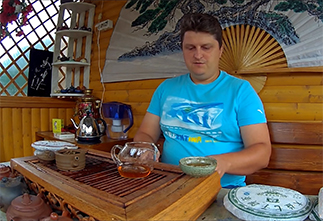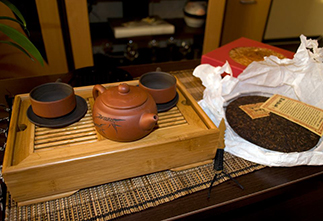Shu Puer "Wu Jin Gong Bing" (乌金贡饼) 2020 by Zhoushi: the shine of "Black Gold"
Wu Jin Gong Bing (乌金贡饼, Wūjīn gòng bǐng) translates as "Black Gold Tax (or Palace) Cake" - this name itself speaks of the high quality and premium nature of the tea. This shu pu-erh (熟普洱, Shú pǔ'ěr) was produced in 2020 by the Zhoushi factory (周氏, Zhōu shì) from raw materials collected in the Yunnan province and pressed into a classic 357-gram Bing Cha (饼茶, Bǐng chá) cake. The Zhoushi family brand presents this product, positioning it as a high-quality shu pu-erh.
Name and concept: "Black gold" and "Tax pancake"
The name "Wu Jin Gong Bing" contains several important layers of meaning:
- Gong Bing (贡饼, Gòng bǐng ): Literally "tax cake" or "palace cake". Historically, the term "Gong Cha" (贡茶, Gòng chá) referred to tea supplied to the imperial court as tribute. In the modern context, "Gong Bing" or "Gong Ting" (宫廷 - palace) indicates the use of high-quality raw materials - tender, young leaves and a large number of golden tea buds (金芽 - jīn yá). Such tea is distinguished by its special softness, smoothness, sweetness and purity of taste.
- Wu Jin (乌金, Wūjīn ): Translated as "black gold". "Wu" (乌) refers to the deep, dark color of the tea itself (leaves and infusion), characteristic of shu pu'er. "Jin" (金 - gold) emphasizes the value of the product and hints at the presence of golden buds in the raw material, which give the tea not only taste, but also a beautiful appearance.
Vintage 2020: the balance of youth and the beginning of maturity
The 2020 tea (approximately 4.5 years old) is at an interesting stage. It is aged enough to get rid of any possible harsh notes of fresh fermentation ("dui wei"), but still retains sufficient freshness and brightness of flavor. This age is often considered a good compromise for shu pu-erh - it is already pleasant to drink, but also has potential for further development.
Appearance
The classic 357-gram cake is a convenient and traditional form for storing and gradually drinking pu-erh. The surface of the cake looks attractive: a mixture of dark brown and black fermented leaves with a noticeable sprinkling of golden-red buds (Jin Ya). The pressing is moderate, allowing you to examine the raw material.
Taste and aroma: smooth and sweet
- Aroma: Clean, sweet, warm. Notes of dark chocolate, dates, caramel, fudge, light nutty or woody (sandalwood, old wood) tones.
- Taste: Exceptionally smooth, soft, velvety, dense. Sweetness dominates – chocolate, date, caramel. Woody notes are noble and well integrated. Bitterness or astringency are practically absent.
- Infusion: Thick, clear, rich chestnut color.
- Aftertaste: Long, sweet, warming and comfortable.
Brewing recommendations
For shu puerh from delicate raw materials:
- Preparation: Carefully chip off 5-7 grams of tea.
- Water: Boiling water (95-100°C).
- Rinsing: 1-2 quick rinses to clean and awaken the leaf.
- Brewing: By steeping. Start with short exposures (10-15 seconds), as raw materials with buds can give off flavor faster. Gradually increase the time. The tea can withstand many steeps.
The 2020 Wu Jin Gong Bing shu puer from the Zhoushi factory is positioned as a premium product, which is reflected in its name. It is an exceptionally smooth, soft, sweet and pure shu puer, made from high-quality raw materials with an abundance of golden buds. Its moderate age makes it ready to drink now, offering a rich chocolate-date profile and velvety texture. It is an excellent choice for those looking for refined, comfortable and high-quality shu.
|
Name in Chinese
|
乌金贡饼 |
|
Pinyin
|
Wūjīn gong bǐng |
|
Country
|
China |
|
Provinces
|
Yunnan (云南) |
|
Manufacturer
|
Чжоуши (周氏) |
|
Raw material production date
|
2020 |
|
Year of pressing
|
2020 |
|
Pressing form
|
Bing Cha (Cake Tea) |
- Комментарии
- Вконтакте
Pu-erh is one of the most unique types of tea, which only gets better with age. Many people, when they first encounter this tea, wondered: why is pu-erh more often found in pressed form (cakes, bricks, tochas), and not in loose form? The reasons for this are related to both history and the practical aspects of storing and fermenting tea. Despite modern technologies that allow the production of loose pu-erh, the shape of pressed cakes remains unchanged. And pu-erh is more often found on sale in pressed form, for example, in the form of cakes or bricks, and loose pu-erh is less common. We will talk about the reasons for pressing pu-erh into cakes in this article.
Puer is a unique Chinese tea that is distinguished by its depth of taste, complexity of aromas and versatility of aftertaste. Its taste characteristics are formed under the influence of many factors, from growing conditions to the brewing method. Let's look at the main ones.
The question often arises: how to brew puerh correctly? Sometimes the phrase "to get high" is added to it. Moreover, everyone has their own understanding of this phrase. Some mean vigor, and some - intoxication. So how to brew puerh tea correctly? Let's consider several options.
Traveling through the tea mountains, we found ourselves in another land of blue roofs - the village of Zhongcai, which is located in the Menghai district of Yunnan province. According to tradition, we were shown another local tea tree, which, according to the Chinese, is at least a million years old :) The village is very authentic, not designed for tourists, there are many wild pu-erhs there and, of course, we were warmly received. They treated us to local cuisine and tea. We also asked the residents about the prices of tea and how they have changed in recent years.
Well, finally we got to the Zhoushi puer factory, which is located in Menghai, Yunnan Province. We first purchased their cakes remotely several years ago and they were to the taste of Russian tea people. Now it's time to personally meet the owners and expand the range of this brand on the shelves of ChL. In this video, you will see the production process of the already familiar cakes, rare shots of the nuances of packaging and the atmosphere of such places.
The tea ceremony occupies a special place in the centuries-old Eastern tradition. And although the essence of this phenomenon remains constant, the nature and external manifestations of the tea ceremony in different nations have their own national characteristics. In each Chinese province, the tea ceremony and the tea used in it are varied: for example, residents of the southern provinces prefer green tea, and residents of the northern provinces - red tea, in Fujian province they more often use Oolong tea, and in Yunnan province Puer tea is widely known.

























































































